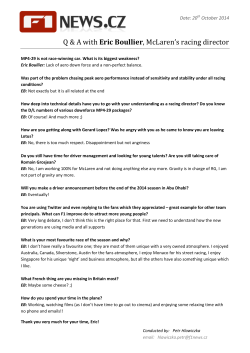
TRANSPORT AUTOMOTIVE WIND ENERGY Core Shell Technology
Core Shell Technology The ability of Plexus structural ITW Plexus specialises in the design methacrylate adhesives to absorb and manufacture of sophisticated energy without catastrophic failure is achieved by our patented core–shell structural adhesives and primers impact modifiers have enhanced for the bonding of materials used resistance to fracture, impact, fatigue in such diverse markets as and thermal stress throughout our methacrylate range, and done so transportation, marine, wind without sacrifice to other properties. energy, automotive, engineering The overall result has improved toughness and resulted in higher peel TRANSPORT AUTOMOTIVE WIND ENERGY ENGINEERED CONSTRUCTION AGRICULTURE MARINE and construction. strength. ”Why bond a racing yacht using bolted flanges, when you can use Plexus structural adhesive to bond two completely finished and varnished halves along the centerline flange?” Technical Support, Solutions and Development Our European Technical Centre can offer; • Full support and service for customers’ technical requirements • Fully equipped laboratory enabling us to carry out testing on our customers’ own substrates • European Research and Development Chief Design Engineer, Luca Olivari department providing continuous improvements to existing products tells us the theory behind his and new developments innovative method of construction. • Comprehensive technical data and usage sheets available • Sales audits available Plexus MMA Properties • Bonds painted/coated metals, ABS, acrylics, polyesters, vinyls, fibreglass, gelcoats and laminates • Minimal surface preparation required • Strong bonds • Variable gap fill • High impact resistance • Shear strength • Excellent fatigue properties • Wide range of working and fixture times available ITW PLEXUS, a division of Performance Polymers Europe, Unit 3, Shipton Way, Express Business Park, Northampton Road, Rushden, Northants NN10 6GL T: +44 (0) 1933 354550 F: +44 (0) 1933 354555 E-mail: sales@itwppe.eu www.itwplexus.eu CASE STUDY - AWARD WINNING RACING YACHT, PORTOBELLO USES PLEXUS STRUCTURAL ADHESIVE “The flanges and joints were designed and projected in such a way that they became a fundamental structural element which reinforced the keel and the keel step. A 5 mm gap between the flanges was allowed for the injection of Plexus MA 590. This was chosen for its strength and ability to maintain excellent mechanical properties even with variations in the thickness of the flanges. For many years, the universally adopted way of constructing the vital joint between deck and hull in both sailing yachts and motorboats, has been to use bolted flanges together with an over-laminating process. The fact is that whilst the style of sailing yachts and motorboats has been greatly influenced by this method of construction, the building process is quite timeconsuming because the fitting of internal structures, engines, electrical wiring and furniture is all delayed by this traditional way of construction. MA590 were split down the middle and then bonded together during powerboat for the Victory team led Luca Olivari to develop two halves of the a number of structural bonding applications that fully hull. So we made exploited the potential of this new generation of the yacht in two adhesives. halves – each completely finished Mr. Olivari told us: “I had the chance to put my ideas and varnished inside - and then into practice with a project for a 28 foot match racing bonded them together along a yacht, called Portobello, designed by Judel &Vrolijk. centerline flange. only because it provides The design was based on tried and tested materials “Finally, after mounting the high strength and and techniques commonly used in prototypes of racing rigging, we bonded the elongation but also yachts. deckhouse and cockpit to the provides a long open time “Crucially, during the design of the components I was able deck using Plexus MA 590 (90 to 105 minutes) and is to take into account the fact that we would be assembling adhesive. This technique resistant to salt water. Our the yacht using structural adhesives. The result was considerably reduced the Core shell technology MMA’s are used to bond interesting because we were able to determine that the construction time because the 1:1 mix ratio virtually all thermoplastics, joints were acting as reinforcing elements. The division lamination of the half-hull Out performs laminated joints between deck and hull, normally horizontal, was designed sections was much easier than in Easily mixable longitudinally, following the line of the keel. The boat was a closed mould. Also, the Reduces cracking and crazing of gelcoats therefore made up of two half moulds, each taking the assembly and bonding was form of the hull and part of the deck. Another mould rendered much simpler through or bulk dispensing made up just the deckhouse and cockpit. The internal the ease of access to the inside of equipment. structure was also made from a mould, in particular the the hull. High gap fill Long open time MA560-1 bulkheads, which the joining of the 500 SERIES KEY FACTS MA530 “The result of using Plexus structural adhesives was that that quality of the joint was significantly better compared to the traditional wet tabbing or over laminating which is done by hand. Early success with the engineering of a Class 1 racing In recent times, the development of structural adhesives like those produced by ITW Plexus, has gives us the possibility of radically improving the design of the structure using composites. It is now quite feasible to bond the hull and deck without the use of mechanical fastenings or the need to laminate over the joint. “ MA 590 is perfectly suited for marine applications not metals and composite materials, and can be applied by hand applicators Furthermore the mechanical stress generated by bolts was eliminated and there was a reduction in production time and therefore labour costs. This construction technique could be adopted for both sailing yachts and motorboats in commercial production models, and the technique appears very attractive. In fact I do not believe the ultimate potential has yet been fully realised.” ”
© Copyright 2025














